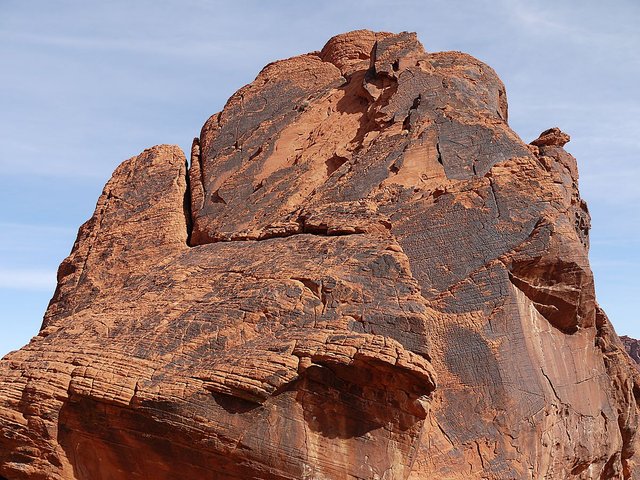Desert-like rocks in southern Belgium?
I have here this sandstone from the Famenne region in Belgium (map below). The sandstone itself was found in a valley that cut into Devonian material, and was filled again with Quaternary fluvial and colluvial deposits. But the thing that is most significant is the dark coating on one side of the rock. It looks very similar to the "desert varnish" that can often be observed in old arid regions The varnish can be used for paleoenvironmental reconstruction, but would that also be the case for these rocks?
Desert varnish or rock coating?
Desert varnish or Patina is a dark and thin coating of generally iron and manganese oxides, together with clay particles on the surface of rocks in desert regions. It is thought to originate from dew and soil moisture that are brought to the surface by capillary forces and evaporate on the surface. The dissolved minerals (most likely from the surrounding rocks themselves), together with small particles in the atmosphere then accumulate on the surface and cause the black layer. This process is extremely slow and it is estimated for such coatings to grow by only a few micrometers per millennium.
Image of rock varnish (dark deposits) on an Aztec Sandstone in the Valley of Fire State Park. This image is licensed under the Creative Commons Attribution-Share Alike 2.5 Canada license by Óðinn.
But not all coatings are varnishes. True varnish is characterized by the clay minerals that are incorporated in the coating and thus impose a layered structure. When this is not present, the same iron and manganese coating would be classified as a heavy-metal skin. These can develop much faster and are more common in various parts of the world, in contrast with the true varnish. Rocks regularly exposed to water can develop such coatings in a mere decade or even only a few years due to the high mobility of these minerals in water compared to the mobility in air.
Analysis of the sandstone fragment
Situation of the Famenne region where the sandstones are found. This illustration is licensed under the Creative Commons Attribution-Share Alike 3.0 Unported license by NordNordWest.
During the formation of the sandstone, the region was not part of an arid region, so we already might assume we aren't dealing with the real desert varnish. To verify, the material has been analysed with a scanning electron microscope (SEM-EDS) for viewing the structure of the coating, and an XDR analysis (X-ray diffraction) for detecting the present elements. Due to a nifty property of SEM's the XDR can be executed with the equipment of the SEM.
Cross sections of the coating showing no layered structure. (Goossens et al., 2015)
X-ray defraction showing the present elements in both the coating and the substrate. (Goossens et al., 2015)
The coating on the sandstones in the Famenne region are indeed coatings of Iron and Manganese oxides and no layered clay particles are observed in the cross sections. The two graphs indicate the high Manganese and Iron concentrations in the coating compared to the substrate, but also show the presence of Al, Si and K which propose the presence of clays.
The coating can be assumed to originate from deposits of elements by water and not by atmosperic deposition. This explains the thickness of the coating (almost 1 mm) and the presence of clay without a layered structure. The potential source of this Manganese could be the late Devonian shales in which the valley is incised, but this has not yet been confirmed by research.
Conclusion
Researches like this are useful for estimating previous environments. I bought this rock including the paper for a charity action of our faculty and I found the analysis rather interesting! I did not execute the research by myself, so I might have gotten some conclusions wrong. In that case I would like to know!
Sources
https://www.britannica.com/science/desert-varnish
http://alliance.la.asu.edu/dorn/VarnishPages/RockCoatingsWeb/DesertRockCoatings.html
Goossens, D., Mees, F., Van Ranst, E., Tack, P., Vincze, L., & Poesen, J. (2015). Rock fragments with dark coatings in slope deposits of the Famenne region, southern Belgium. Belgeo, (4), 0–14. https://doi.org/10.4000/belgeo.17625
Parsons, A. (2009). Geomorphology of Desert Environments (2.nd ed.). Dordrecht: Springer Netherlands.

Beautiful Desert and Fantastic story @samve